Android 几种换肤方式和原理分析
Posted Jason_Lee155
tags:
篇首语:本文由小常识网(cha138.com)小编为大家整理,主要介绍了Android 几种换肤方式和原理分析相关的知识,希望对你有一定的参考价值。
1.通过Theme切换主题
通过在setContentView之前设置Theme实现主题切换。
在styles.xml定义一个夜间主题和白天主题:
<style name="LightTheme" parent="Theme.AppCompat.Light.DarkActionBar">
<item name="colorPrimary">@color/colorPrimary</item>
<item name="colorPrimaryDark">@color/colorPrimaryDark</item>
<item name="colorAccent">@color/colorAccent</item>
<!--主题背景-->
<item name="backgroundTheme">@color/white</item>
</style>
<style name="BlackTheme" parent="Theme.AppCompat.Light.DarkActionBar">
<item name="colorPrimary">@color/colorPrimary</item>
<item name="colorPrimaryDark">@color/colorPrimaryDark</item>
<item name="colorAccent">@color/colorAccent</item>
<!--主题背景-->
<item name="backgroundTheme">@color/dark</item>
</style>
设置主要切换主题View的背景:
<android.support.constraint.ConstraintLayout xmlns:android="http://schemas.android.com/apk/res/android"
xmlns:app="http://schemas.android.com/apk/res-auto"
xmlns:tools="http://schemas.android.com/tools"
android:layout_width="match_parent"
android:layout_height="match_parent"
android:background="?attr/backgroundTheme"
tools:context=".MainActivity">
<Button
android:id="@+id/btn"
android:layout_width="wrap_content"
android:layout_height="wrap_content"
android:text="切换主题"
app:layout_constraintBottom_toBottomOf="parent"
app:layout_constraintLeft_toLeftOf="parent"
app:layout_constraintRight_toRightOf="parent"
app:layout_constraintTop_toTopOf="parent" />
</android.support.constraint.ConstraintLayout>
切换主题:
通过调用setTheme()
@Override
protected void onCreate(Bundle savedInstanceState)
super.onCreate(savedInstanceState);
setTheme(R.style.BlackTheme);
setContentView(R.layout.activity_main);
finish();
Intent intent = getIntent();
intent.setFlags(Intent.FLAG_ACTIVITY_NEW_TASK | Intent.FLAG_ACTIVITY_CLEAR_TASK);
startActivity(intent);
overridePendingTransition(0, 0);
2.通过AssetManager切换主题
下载皮肤包,通过AssetManager加载皮肤包里面的资源文件,实现资源替换。
ClassLoader
Android可以通过classloader获取已安装apk或者未安装apk、dex、jar的context对象,从而通过反射去获取Class、资源文件等。
加载已安装应用的资源
//获取已安装app的context对象
Context context = ctx.getApplicationContext().createPackageContext("com.noob.resourcesapp", Context.CONTEXT_INCLUDE_CODE | Context.CONTEXT_IGNORE_SECURITY);
//获取已安装app的resources对象
Resources resources = context.getResources();
//通过resources获取classloader,反射获取R.class
Class aClass = context.getClassLoader().loadClass("com.noob.resourcesapp.R$drawable");
int resId = (int) aClass.getField("icon_collect").get(null);
imageView.setImageDrawable(resources.getDrawable(id));
加载未安装应用的资源
String apkPath = Environment.getExternalStorageDirectory().getAbsolutePath() + "/test.apk";
//通过反射获取未安装apk的AssetManager
AssetManager assetManager = AssetManager.class.newInstance();
//通过反射增加资源路径
Method method = assetManager.getClass().getMethod("addAssetPath", String.class);
method.invoke(assetManager, apkPath);
File dexDir = ctx.getDir("dex", Context.MODE_PRIVATE);
if (!dexDir.exists())
dexDir.mkdir();
//获取未安装apk的Resources
Resources resources = new Resources(assetManager, ctx.getResources().getDisplayMetrics(),
ctx.getResources().getConfiguration());
//获取未安装apk的ClassLoader
ClassLoader classLoader = new DexClassLoader(apkPath, dexDir.getAbsolutePath(), null, ctx.getClassLoader());
//反射获取class
Class aClass = classLoader.loadClass("com.noob.resourcesapp.R$drawable");
int id = (int) aClass.getField("icon_collect").get(null);
imageView.setImageDrawable(resources.getDrawable(id));
3.在view生成的时候去动态加载背景
思考先:一个TextView在xml简析时,后面会经历什么呢?setContentView(R.id.activity_main)后面经历了什么呢?
直接说答案:

Activity -> OnCreat的流程如下:
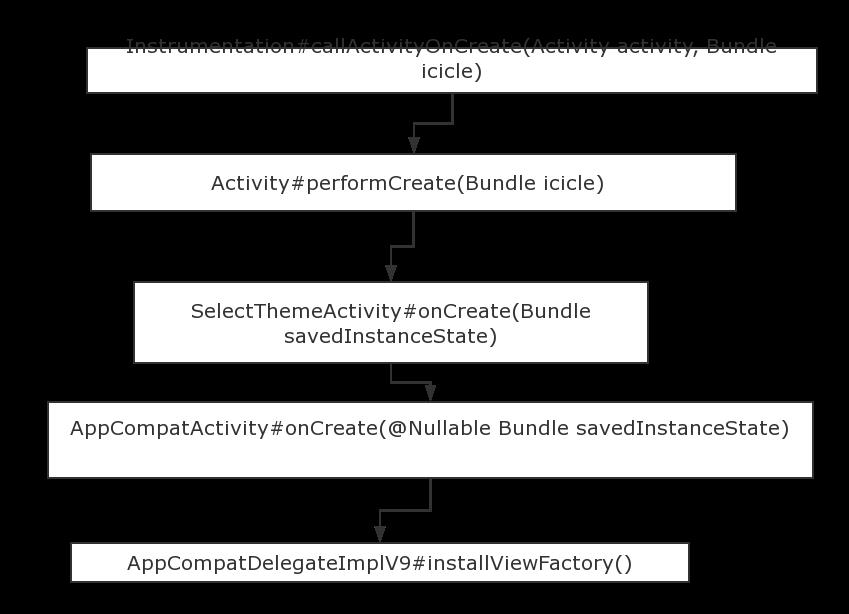
然后:

这里注意一点layoutInflater.getFactory(),返回的是LayoutInflater的一个内部接口Factory。默认没有人为干预的情况下,我们不设置Factory的情况下,layoutInflater.getFactory()等于null,系统会自己创建一个Factory去处理XML到View的转换。反之,如果我们设置了自己的Factory,那么系统就会走我们Factory的onCreateView,他会返回一个我们定制化的View。
Factory定义如下:
public interface Factory
/**
* Hook you can supply that is called when inflating from a LayoutInflater.
* You can use this to customize the tag names available in your XML
* layout files.
*
* <p>
* Note that it is good practice to prefix these custom names with your
* package (i.e., com.coolcompany.apps) to avoid conflicts with system
* names.
*
* @param name Tag name to be inflated.
* @param context The context the view is being created in.
* @param attrs Inflation attributes as specified in XML file.
*
* @return View Newly created view. Return null for the default
* behavior.
*/
public View onCreateView(String name, Context context, AttributeSet attrs);
Factory
Factory是一个很强大的接口。当我们使用inflating一个XML布局时,可以使用这个类进行拦截解析到的XML中的标签属性-AttributeSet和上下文-Context,以及标签名称-name(例如:TextView)。然后我们根据这些属性可以创建对应的View,设置一些对应的属性。
比如:我读取到XML中的TextView标签,这时,我就创建一个AppCompatTextView对象,它的构造方法中就是我读取到的XML属性。然后,将构造好的View返回即可。
默认情况下,从context.getSystemService(Context.LAYOUT_INFLATER_SERVICE)得到LayoutInflater,通过layoutInflater.getFactory()刚开始是null,然后执行LayoutInflaterCompat.setFactory(layoutInflater, this);方法。
看下这个方法:
* Attach a custom Factory interface for creating views while using
* this LayoutInflater. This must not be null, and can only be set once;
* after setting, you can not change the factory.
*
* @see LayoutInflater#setFactory(android.view.LayoutInflater.Factory)
*/
public static void setFactory(LayoutInflater inflater, LayoutInflaterFactory factory)
IMPL.setFactory(inflater, factory);
在这里我们关注下传入的LayoutInflaterFactory的实例,最终这个设置的LayoutInflaterFactory传入到哪里了呢?向下debug,进入LayoutInflater中的下面:

给mFactory = mFactory2 = factory执行了,进行mFactory和mFactory2的赋值。
到这里为止,初始化好了LayoutInflater和LayoutInflaterFactory。
好了,现在就走完了SelectThemeActivity#onCreate中的super.onCreate(savedInstanceState);下面开始走setContentView(R.layout.activity_select_theme);
setContentView(int resId)
setContentView会走到LayoutInflate的下面这里:
public View inflate(@LayoutRes int resource, @Nullable ViewGroup root, boolean attachToRoot)
final Resources res = getContext().getResources();
if (DEBUG)
Log.d(TAG, "INFLATING from resource: \\"" + res.getResourceName(resource) + "\\" ("
+ Integer.toHexString(resource) + ")");
//在这里将Resource得到layout的XmlResourceParser对象
final XmlResourceParser parser = res.getLayout(resource);
try
return inflate(parser, root, attachToRoot);
finally
parser.close();
再向下就到了LayoutInflate重点:
public View inflate(XmlPullParser parser, @Nullable ViewGroup root, boolean attachToRoot)
synchronized (mConstructorArgs)
.....
//将上面给我的XmlPullParser转换为对应的View的属性AttributeSet供View的构造方法或其他方法使用
final AttributeSet attrs = Xml.asAttributeSet(parser);
....
try
if
....
else
//默认布局会走到这里,Temp是XML文件的根布局
// Temp is the root view that was found in the xml
final View temp = createViewFromTag(root, name, inflaterContext, attrs);
...
// Inflate all children under temp against its context.
rInflateChildren(parser, temp, attrs, true);
....
//添加解析到的根View
// to root. Do that now.
if (root != null && attachToRoot)
root.addView(temp, params);
....
catch (XmlPullParserException e)
....
return result;
进入到createViewFromTag方法之中,会进入到LayoutInflate的View createViewFromTag(View parent, String name, Context context, AttributeSet attrs, boolean ignoreThemeAttr)中。
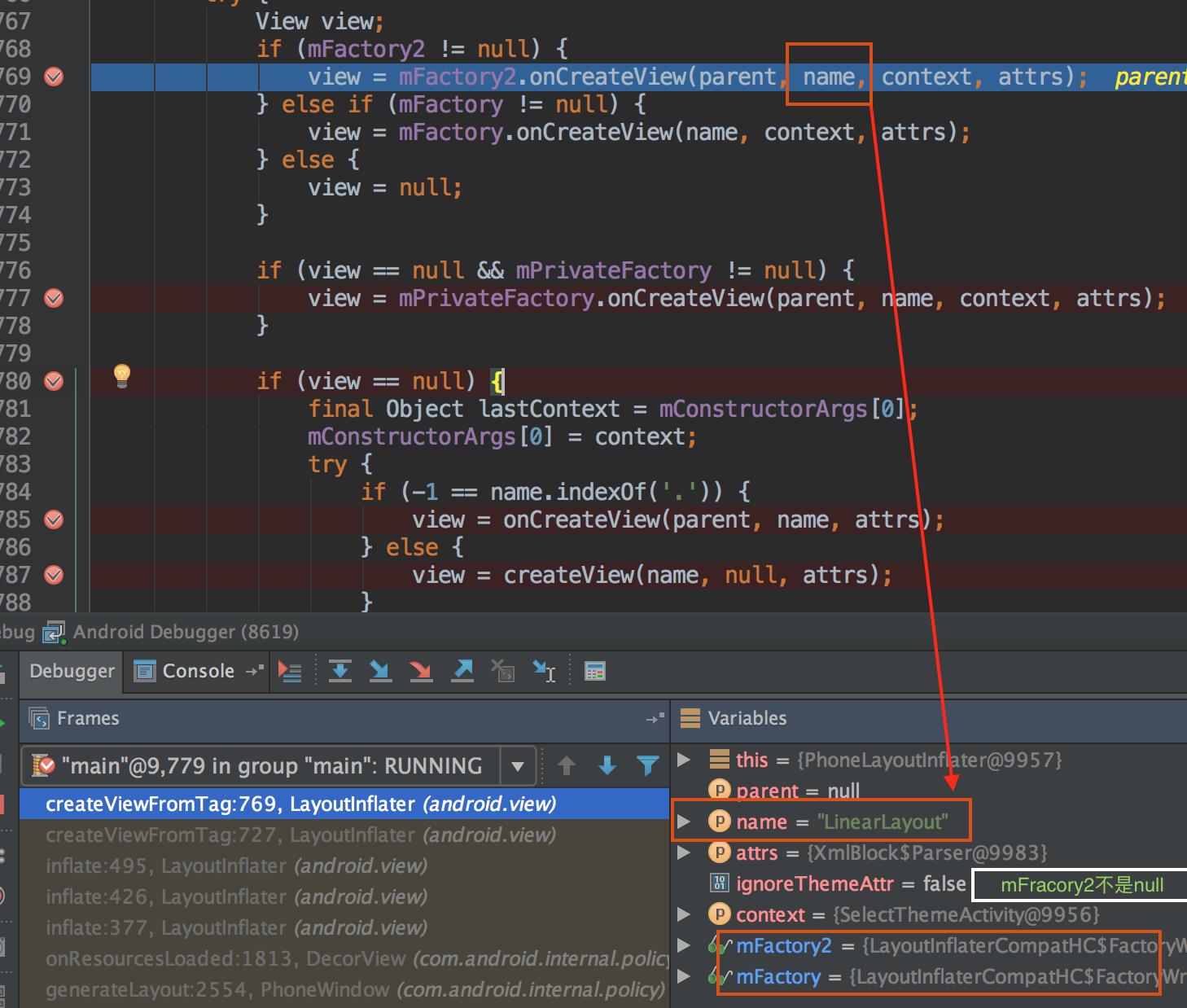
这里的name传入的就是就是解析到的标签值LinearLayout。
@Override
public final View onCreateView(View parent, String name, Context context, AttributeSet attrs)
// First let the Activity's Factory try and inflate the view
先试着进行解析布局
final View view = callActivityOnCreateView(parent, name, context, attrs);
if (view != null)
return view;
// If the Factory didn't handle it, let our createView() method try
return createView(parent, name, context, attrs);
很遗憾, callActivityOnCreateView返回的总是null:
@Override
View callActivityOnCreateView(View parent, String name, Context context, AttributeSet attrs)
// On Honeycomb+, Activity's private inflater factory will handle calling its
// onCreateView(...)
return null;
然后进入到下面的,createView(parent, name, context, attrs);中。重点来了!!!,期盼已久的看看Google源码是如何创建View的。
从XML到View的华丽转身

担心图片失效,再复制一遍代码:
public final View createView(View parent, final String name, @NonNull Context context,
@NonNull AttributeSet attrs, boolean inheritContext,
boolean readAndroidTheme, boolean readAppTheme, boolean wrapContext)
final Context originalContext = context;
// We can emulate Lollipop's android:theme attribute propagating down the view hierarchy
// by using the parent's context
if (inheritContext && parent != null)
context = parent.getContext();
if (readAndroidTheme || readAppTheme)
// We then apply the theme on the context, if specified
context = themifyContext(context, attrs, readAndroidTheme, readAppTheme);
if (wrapContext)
context = TintContextWrapper.wrap(context);
View view = null;
// We need to 'inject' our tint aware Views in place of the standard framework versions
switch (name)
case "TextView":
view = new AppCompatTextView(context, attrs);
break;
case "ImageView":
view = new AppCompatImageView(context, attrs);
break;
case "Button":
view = new AppCompatButton(context, attrs);
break;
case "EditText":
view = new AppCompatEditText(context, attrs);
break;
case "Spinner":
view = new AppCompatSpinner(context, attrs);
break;
case "ImageButton":
view = new AppCompatImageButton(context, attrs);
break;
case "CheckBox":
view = new AppCompatCheckBox(context, attrs);
break;
case "RadioButton":
view = new AppCompatRadioButton(context, attrs);
break;
case "CheckedTextView":
view = new AppCompatCheckedTextView(context, attrs);
break;
case "AutoCompleteTextView":
view = new AppCompatAutoCompleteTextView(context, attrs);
break;
case "MultiAutoCompleteTextView":
view = new AppCompatMultiAutoCompleteTextView(context, attrs);
break;
case "RatingBar":
view = new AppCompatRatingBar(context, attrs);
break;
case "SeekBar":
view = new AppCompatSeekBar(context, attrs);
break;
if (view == null && originalContext != context)
// If the original context does not equal our themed context, then we need to manually
// inflate it using the name so that android:theme takes effect.
view = createViewFromTag(context, name, attrs);
if (view != null)
// If we have created a view, check it's android:onClick
checkOnClickListener(view, attrs);
return view;
可以看到,它是拿标签名称进行switch的比较,是哪一个就进入到哪一个中进行创建View。
有人会说,这里没有LinearLayout对应的switch啊。的确。最终返回null。
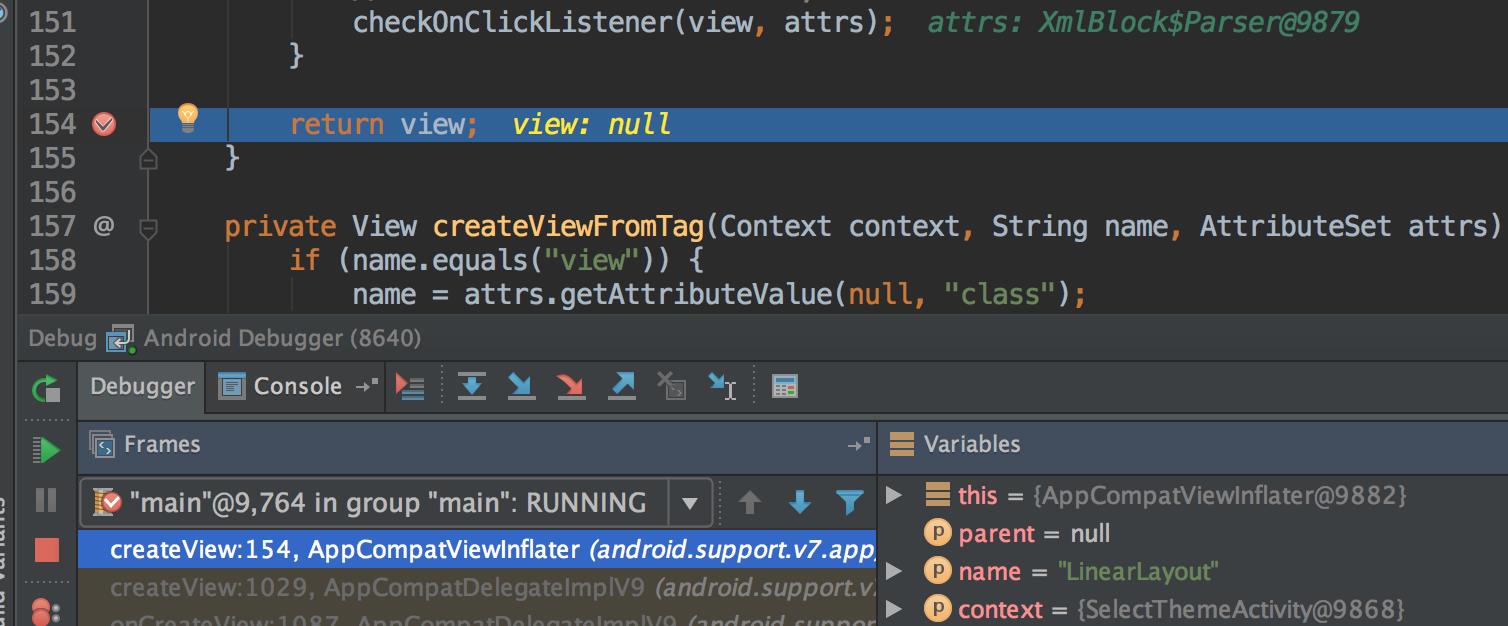
回到最初,由于Line769返回null,同时name值LinearLayout不包含".",进入到Line785onCreateView(parent, name, attrs)。
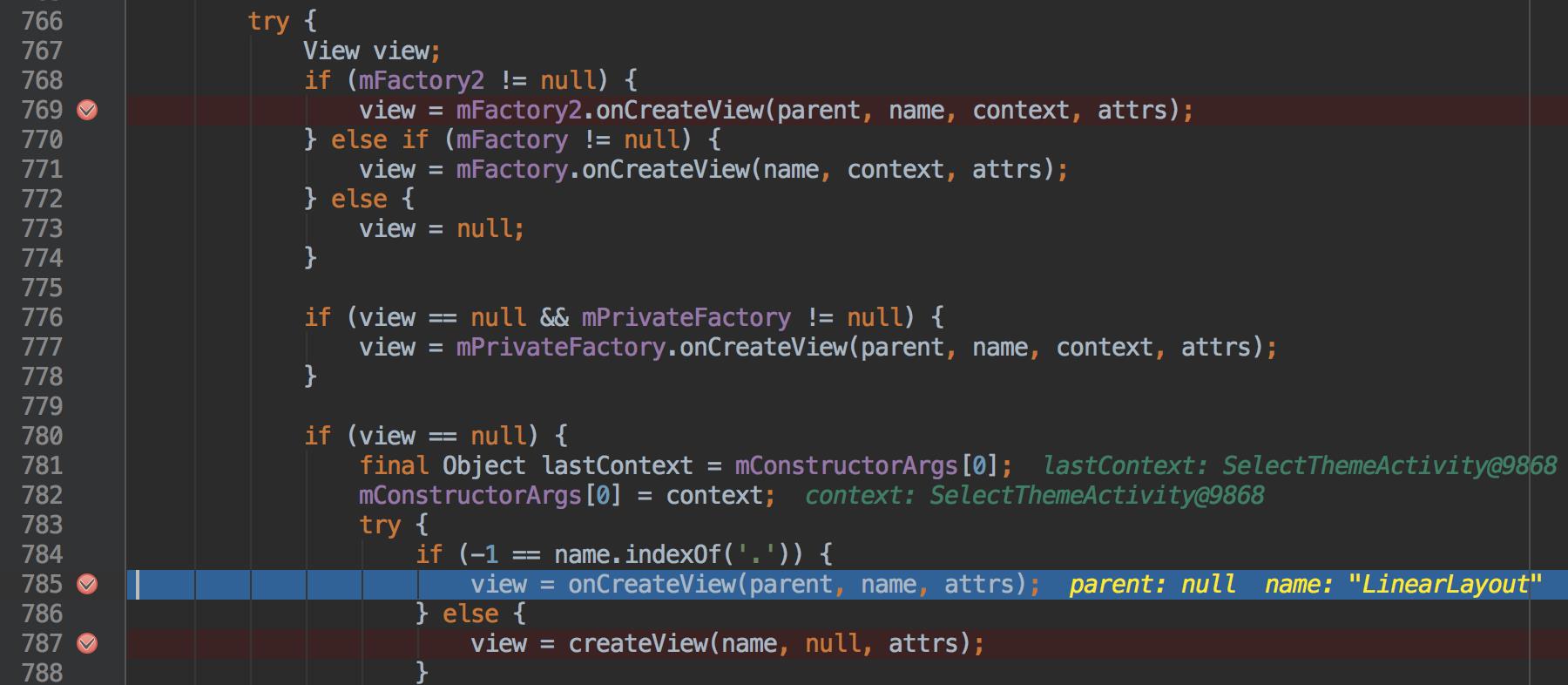
到这里,知道这个标签是LinearLayout了,那么开始创建这个对象了。问题来了,我们知道这个对象名称了,但是它属于哪个包名?如何创建呢?
根据标签名称创建对象
我们知道,Android控件中的包名总共就那么几个:android.widget、android.webkit、android.app,既然就这么几种,干脆挨个用这些字符串进行如下拼接:
android.widget.LinearLayout、android.webkit.LinearLayout、android.app.LinearLayout、,然后挨个创建对象,一旦创建成功即说明这个标签所在的包名是对的,返回这个对象即可。
那么,从上面debug会进入到如下源码:
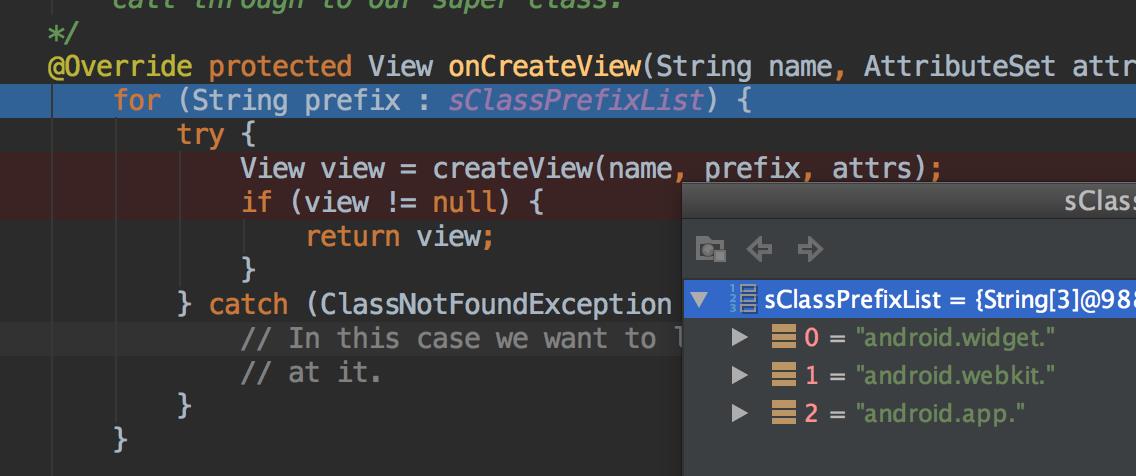
sClassPrefixList的定义如下:
private static final String[] sClassPrefixList =
"android.widget.",
"android.webkit.",
"android.app."
;注意:是final的
创建Android布局标签对象
继续向下,进入到真正的创建Android布局标签对象的实现。在这个方法中,才是“android.widget.”包下的,LinearLayout、RelativeLayout等等的具体实现。
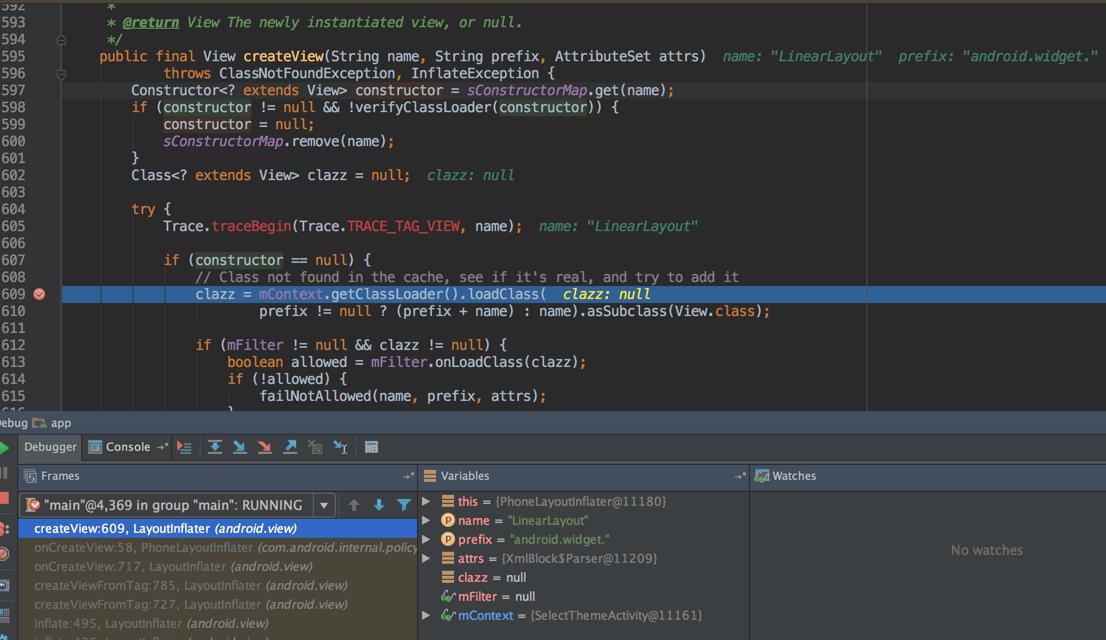
name="LinearLayout"
prefix="android.widget."
分析下这段代码(下面的方法中去掉了一些无用代码):
public final View createView(String name, String prefix, AttributeSet attrs)
throws ClassNotFoundException, InflateException
//step1 :sConstructorMap是<标签名称:标签对象>的map,用来缓存对象的。第一次进入时,这个map中是空的。
Constructor<? extends View> constructor = sConstructorMap.get(name);
if (constructor != null && !verifyClassLoader(constructor))
constructor = null;
sConstructorMap.remove(name);
Class<? extends View> clazz = null;
try
//step2:在map缓存中没有找到对应的LinearLayout为key的对象,则创建。
if (constructor == null)
// Class not found in the cache, see if it's real, and try to add it
//step3:【关键点,反射创建LinearLayout对象】,根据"prefix + name"值是"android.widget.LinearLayout"加载对应的字节码文件对象。
clazz = mContext.getClassLoader().loadClass(
prefix != null ? (prefix + name) : name).asSubclass(View.class);
if (mFilter != null && clazz != null)
boolean allowed = mFilter.onLoadClass(clazz);
if (!allowed)
failNotAllowed(name, prefix, attrs);
//step4:获取LinearLayout的Constructor对象
constructor = clazz.getConstructor(mConstructorSignature);
constructor.setAccessible(true);
//step5:缓存LinearLayout的Constructor对象
sConstructorMap.put(name, constructor);
else
// If we have a filter, apply it to cached constructor
if (mFilter != null)
// Have we seen this name before?
Boolean allowedState = mFilterMap.get(name);
if (allowedState == null)
// New class -- remember whether it is allowed
clazz = mContext.getClassLoader().loadClass(
prefix != null ? (prefix + name) : name).asSubclass(View.class);
boolean allowed = clazz != null && mFilter.onLoadClass(clazz);
mFilterMap.put(name, allowed);
if (!allowed)
failNotAllowed(name, prefix, attrs);
else if (allowedState.equals(Boolean.FALSE))
failNotAllowed(name, prefix, attrs);
Object[] args = mConstructorArgs;
args[1] = attrs;
//step6:args的两个值分别是SelectThemeActivity,XmlBlock$Parser。到这里就调用了LinearLayout的两个参数的构造方法去实例化对象。至此,LinearLayout的实现也就是Android中的布局文件的实现全部完成。最后把创建的View给return即可。
final View view = constructor.newInstance(args);
if (view instanceof ViewStub)
// Use the same context when inflating ViewStub later.
final ViewStub viewStub = (ViewStub) view;
viewStub.setLayoutInflater(cloneInContext((Context) args[0]));
return view;
......
在这个方法中关键的步骤就是如何去实例化布局标签对象。这也是我们换肤的前提知识。
总结下根据标签+属性创建View的思路:

两个关键点:
- 是否设置了Factory
- Factory的onCreateView是否返回null
再让我们回到最初的地方:

View view;
if (mFactory2 != null)
view = mFactory2.onCreateView(parent, name, context, attrs);
else if (mFactory != null)
view = mFactory.onCreateView(name, context, attrs);
else
view = null;
if (view == null && mPrivateFactory != null)
view = mPrivateFactory.onCreateView(parent, name, context, attrs);
//请注意下面👇这个判断,系统肯定会走上面的mFactory2.onCreateView,
//默认系统的Factory返回的是null,
//所以系统会走下面自己的创建View的实现逻辑。
//如果我们在上面的流程图的第一步中设置了自己的Factory,那么系统
//会调用我们自己的Factory的createView的方法,这个时候,如果我们
//自己的Factory#onCreateView != null,那么就是返回我们的View了。
if (view == null)
final Object lastContext = mConstructorArgs[0];
mConstructorArgs[0] = context;
try
if (-1 == name.indexOf('.'))
view = onCreateView(parent, name, attrs);
else
view = createView(name, null, attrs);
finally
mConstructorArgs[0] = lastContext;
return view;总的换肤开始:
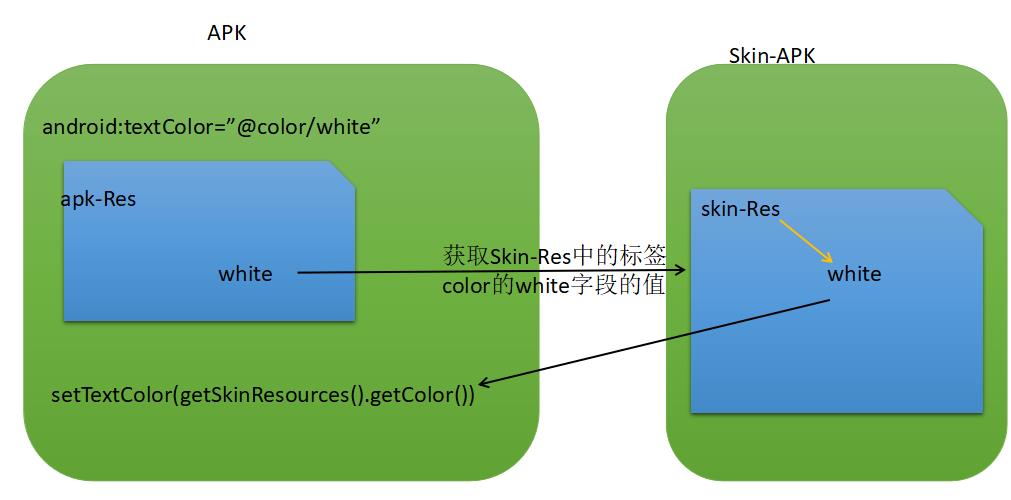
我们通过我们view的属性的值white,拿到skin-apk中的white属性的skinResId,然后根据skinRes.getColor(skinResId)返回color,然后设置到我们的TextView上面。
step1 实现LayoutInflaterFactory接口,创建自己的Factory
public class SkinActivity extends AppCompatActivity
protected LayoutInflaterFactoryImpl layoutInflaterFactory;
@Override
protected void onCreate(Bundle savedInstanceState)
layoutInflaterFactory = new LayoutInflaterFactoryImpl();
LayoutInflaterCompat.setFactory(getLayoutInflater(), layoutInflaterFactory);
super.onCreate(savedInstanceState);
看下运行结果:
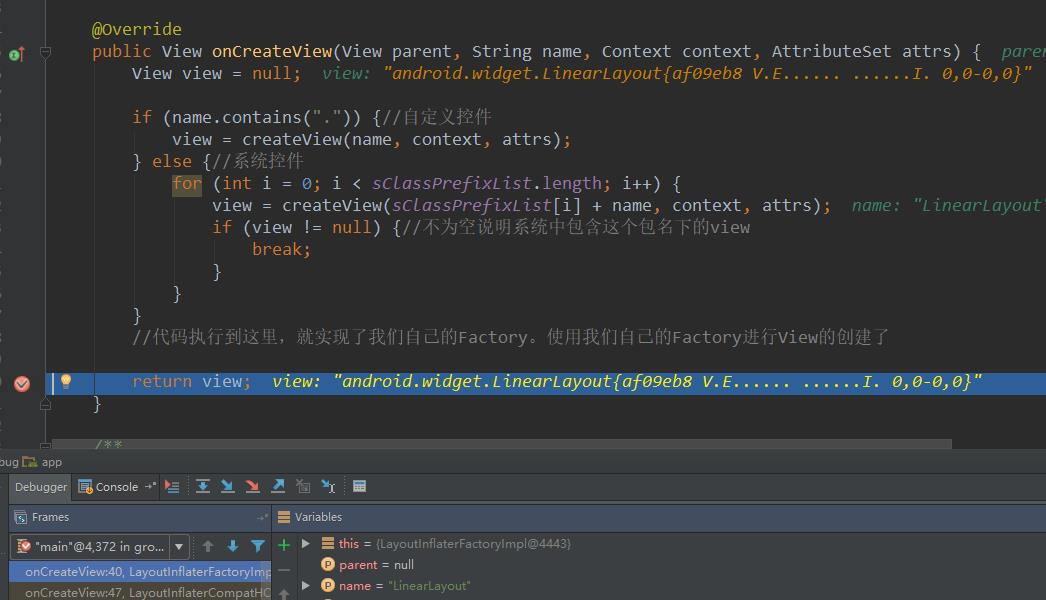
OK!没问题,每一个View的实现我们都可以拦截到,下一步开始拿取View的background、或者TextColor进行相应的更改。
step2 获取view需要换肤的属性

保存view的相关属性
public class ViewAttrs
public String attributeName, resourceEntryName, resourceTypeName;
public int resId;
public ViewAttrs(String attributeName, int resId, String resourceEntryName, String resourceTypeName)
this.attributeName = attributeName;
this.resId = resId;
this.resourceEntryName = resourceEntryName;
this.resourceTypeName = resourceTypeName;
View换肤时的操作
public class SkinView
private View view;
private ArrayList<ViewAttrs> viewAttrses;
public SkinView(View view, ArrayList<ViewAttrs> viewAttrses)
this.view = view;
this.viewAttrses = viewAttrses;
//android:textColor = "@color/red_color"
//android:background = "@mipmap/pic1"
//android:background = "@drawable/selector"
//android:background = "@color/blue_color"
public void changeTheme()
//TODO 待实现的换肤代码
onCreateView创建View后,读取view的属性值,并且保存
/**
* 解析本地view的属性,并保存该view
* 解析:view的属性名称;view的属性值;view的background;view的resId
* @param view
* @param context
* @param attrs
*/
private void saveViewAttrs(View view, Context context, AttributeSet attrs)
//将view的每一种属性 以及对应的值放在list中
ArrayList<ViewAttrs> viewAttrses = new ArrayList<>();
for (int i = 0; i < attrs.getAttributeCount(); i++)
String attributeName = attrs.getAttributeName(i);//background或者textColor
String attributeValue = attrs.getAttributeValue(i);//拿到view的id。类似于@2131361811
if(SkinConstans.BACKGROUND.equalsIgnoreCase(attributeName) || SkinConstans.TEXT_COLOR.equalsIgnoreCase(attributeName))//暂且这样判断,后面会有优化后的代码
int resId = Integer.parseInt(attributeValue.substring(1));//截取@2131361811 ,拿到实际的在R文件中的值
String resourceTypeName = context.getResources().getResourceTypeName(resId);//background的mipmap或者drawable或者color等
String resourceEntryName = context.getResources().getResourceEntryName(resId); //mipmap、drawable、color对应的值
ViewAttrs viewAttrs = new ViewAttrs(attributeName, resId, resourceEntryName, resourceTypeName);
viewAttrses.add(viewAttrs);
if(viewAttrses.size() > 0)
//保存需要换肤的view以及对应的属性
SkinView skinView = new SkinView(view, viewAttrses);
skinViews.add(skinView);
执行换肤时调用:
public void changeTheme()
for (int i = 0; i < skinViews.size(); i++)
skinViews.get(i).changeTheme();
step3 实现加载插件apk,并且拿到插件的资源对象
public void loadSkin(String skinPath)
//------------拿到skinPackageName----------
skinPackageName = context.getPackageManager().getPackageArchiveInfo(skinPath, PackageManager.GET_ACTIVITIES).packageName;
//----------拿到skin中的Resource对象----------
AssetManager assets = null;
try
assets = AssetManager.class.newInstance();
Method addAssetPath = AssetManager.class.getMethod("addAssetPath", String.class);
addAssetPath.invoke(assets, skinPath);
catch (InstantiationException e)
e.printStackTrace();
catch (IllegalAccessException e)
e.printStackTrace();
catch (NoSuchMethodException e)
e.printStackTrace();
catch (InvocationTargetException e)
e.printStackTrace();
skinRes = new Resources(assets, context.getResources().getDisplayMetrics(), context.getResources().getConfiguration());
step 4 获取插件中的resId的值
/**
* @param resId
* @return
*/
public int getColor(int resId)
if (skinRes == null)
return resId;
//通过本地APP中的resId拿到本app对应的资源名称,然后再skin apk中找到该资源名称, 在根据skin中的资源名称 拿到对应的资源值
String resourceName = context.getResources().getResourceName(resId);
//String name, String defType, String skinPackageName 拿到skin包中的resId
int skinResId = skinRes.getIdentifier(resourceName.substring(resourceName.indexOf("/") + 1), SkinConstans.COLOR, skinPackageName);
if (skinResId == 0) //说明在skin皮肤中没有找到对应的resId,则返回原本的resId
return context.getResources().getColor(resId);
return skinRes.getColor(skinResId);
public Drawable getDrawable(int resId)
Drawable drawable = context.getResources().getDrawable(resId);
if (skinRes == null)
return drawable;
String resourceName = context.getResources().getResourceName(resId);
//String name, String defType, String skinPackageName 拿到skin包中的resId
int skinResId = skinRes.getIdentifier(resourceName.substring(resourceName.indexOf("/") + 1), SkinConstans.DRAWABLE, skinPackageName);
if (skinResId == 0) //说明在skin皮肤中没有找到对应的resId,则返回原本的resId
return drawable;
return skinRes.getDrawable(skinResId);
step 5 SkinView中换肤
public void changeTheme()
for (int i = 0; i < viewAttrses.size(); i++)
ViewAttrs viewAttrs = viewAttrses.get(i);
if (SkinConstans.TEXT_COLOR.equalsIgnoreCase(viewAttrs.attributeName))
if (view instanceof TextView)
//替换textColor
if (SkinConstans.COLOR.equalsIgnoreCase(viewAttrs.resourceTypeName))
((TextView) view).setTextColor(SkinManager.getInstance().getColor(viewAttrs.resId));
else if (SkinConstans.BACKGROUND.equalsIgnoreCase(viewAttrs.attributeName))
if (SkinConstans.DRAWABLE.equalsIgnoreCase(viewAttrs.resourceTypeName))
view.setBackgroundDrawable(SkinManager.getInstance().getDrawable(viewAttrs.resId));
else if (SkinConstans.COLOR.equalsIgnoreCase(viewAttrs.resourceTypeName))
view.setBackgroundColor(SkinManager.getInstance().getColor(viewAttrs.resId));
else if (SkinConstans.MIPMAP.equalsIgnoreCase(viewAttrs.resourceTypeName))
代码跑起来
activity_main.xml
<?xml version="1.0" encoding="utf-8"?>
<LinearLayout xmlns:android="http://schemas.android.com/apk/res/android"
xmlns:tools="http://schemas.android.com/tools"
android:id="@+id/activity_main"
android:layout_width="match_parent"
android:layout_height="match_parent"
android:background="@color/activity_main_color"
android:orientation="vertical"
android:paddingTop="@dimen/activity_vertical_margin"
tools:context="xu.myapplication.MainActivity">
<TextView
android:layout_width="match_parent"
android:layout_height="wrap_content"
android:background="@color/text_background_color"
android:text="Hello World!"
android:textColor="@color/text_color" />
<Button
android:text="换肤"
android:onClick="changeTheme"
android:layout_width="wrap_content"
android:layout_height="wrap_content" />
</LinearLayout>
color.xml
<?xml version="1.0" encoding="utf-8"?>
<resources>
<color name="colorPrimary">#3F51B5</color>
<color name="colorPrimaryDark">#303F9F</color>
<color name="colorAccent">#FF4081</color>
<color name="text_color">#aadd00</color>
<color name="text_background_color">#3F51B5</color>
<color name="activity_main_color">#009977</color>
</resources>
MainActivity
public class MainActivity extends SkinActivity
@Override
protected void onCreate(Bundle savedInstanceState)
super.onCreate(savedInstanceState);
setContentView(R.layout.activity_main);
public void changeTheme(View view)
SkinManager.getInstance().initContext(this);
ActivityCompat.requestPermissions(this,
new String[]Manifest.permission.READ_EXTERNAL_STORAGE, Manifest.permission.WRITE_EXTERNAL_STORAGE, 100);
@Override
public void onRequestPermissionsResult(int requestCode, String[] permissions, int[] grantResults)
super.onRequestPermissionsResult(requestCode, permissions, grantResults);
SkinManager.getInstance().loadSkin(Environment.getExternalStorageDirectory().getAbsolutePath()+"/skinplugin-debug.apk");
layoutInflaterFactory.changeTheme();
下面是skin-apk的color.xml
<?xml version="1.0" encoding="utf-8"?>
<resources>
<color name="colorPrimary">#3F51B5</color>
<color name="colorPrimaryDark">#303F9F</color>
<color name="colorAccent">#3F51B5</color>
<color name="text_color">#FF4081</color>
<color name="text_background_color">#1199aa</color>
<color name="activity_main_color">#aadd00</color>
</resources>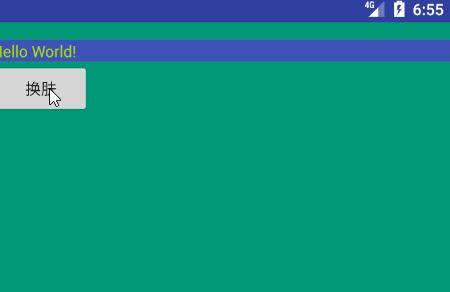
Activity的background和TextView的textColor都换了。
总的来说,原理流程也就是这样。当然代码优化还有很多工作要做,不过先了解了原理,后面也就是时间问题了。
以上是关于Android 几种换肤方式和原理分析的主要内容,如果未能解决你的问题,请参考以下文章